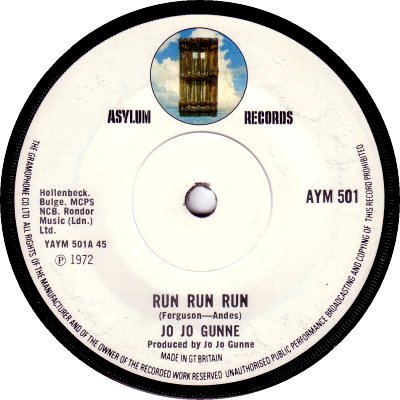
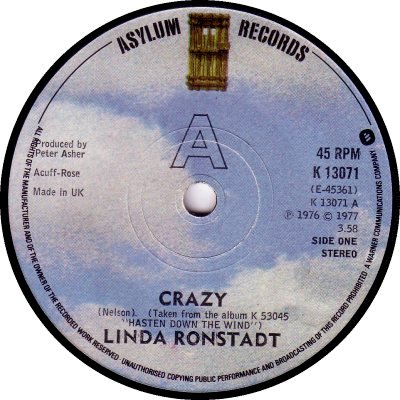
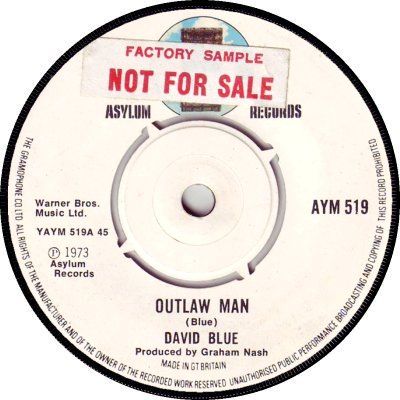
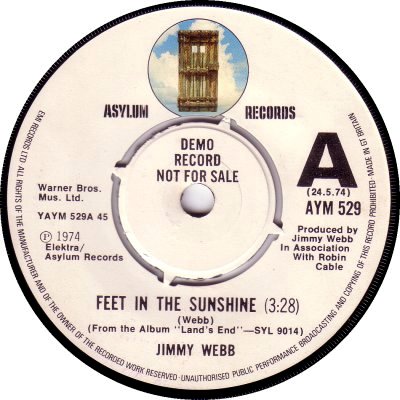
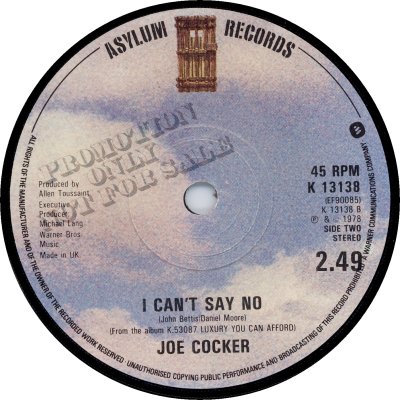
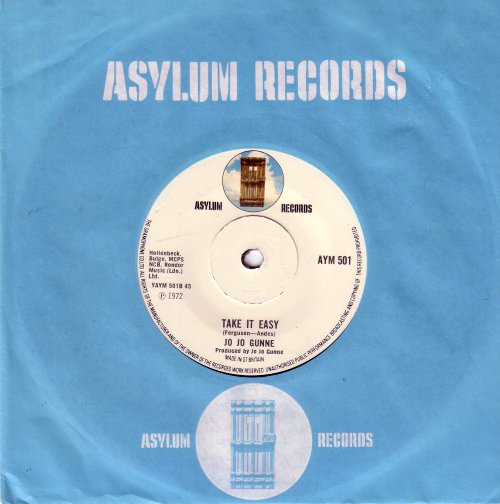
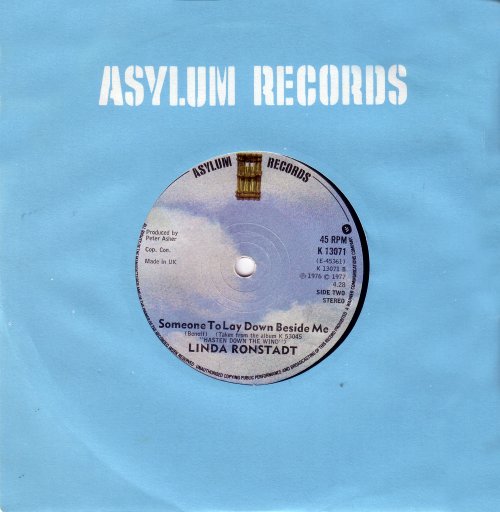
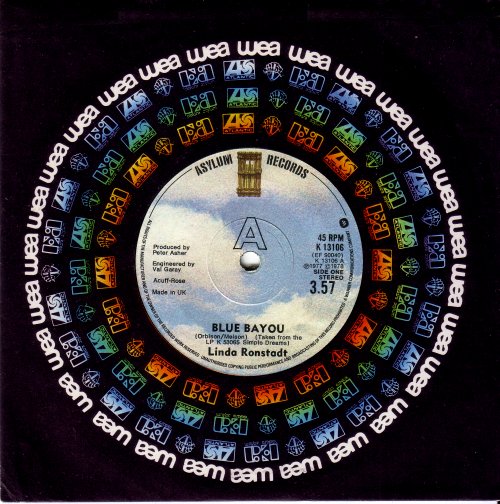
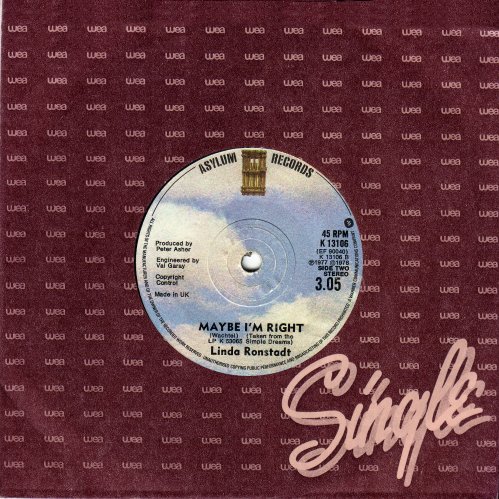
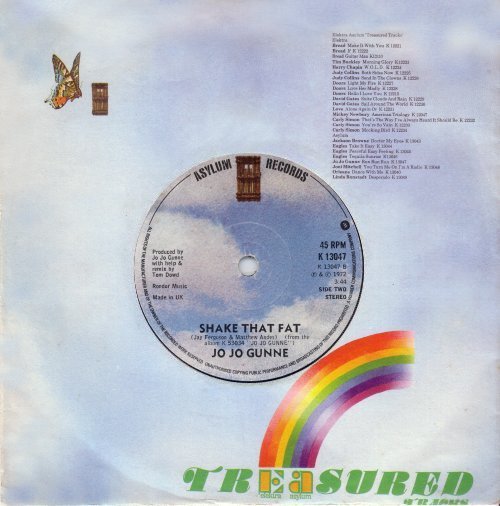
American. Asylum received its first mention in 'Record Retailer' in the issue of the 15th of January 1972, which reported that it was headed by David Geffen and Elliot Roberts, was a joint venture with Atlantic Records, and had been licensed to EMI. The following week's issue added that Geffen and Roberts ran a management company called Shelter Records, which didn't tie artists down to contracts and took no commission if the artist was earning less than $15,000. Asylum, the article said, had been formed at the suggestion of Atlantic's Ahmet Ertegun as an outlet for artists who didn't really fit on Atlantic's own labels. Geffen was quoted as saying that the new label was intended to "Provide a shelter for the artist and a place of refuge for them from the insanity you occasionally meet in the music business." Asylum duly made its debut in the UK in early 1972, and scored an immediate success with its first single, 'Run Run Run' b/w 'Take It Easy' by Jo Jo Gunne (AYM-501; 2/72), which was a Top Ten hit. There were no more hit singles until the summer of 1975 when The Eagles got into the Top Thirty with 'One Of These Nights' b/w 'Visions' (AYM-543; 6/75), but Asylum appears to have been primarily album-orientated.
In the late summer of 1973, following a shake-up at WEA which ended with the company's three main labels being split into autonomous units, David Geffen was made head of Elektra. One of his earliest acts was to transfer Elektra from its current home at Kinney / CBS to EMI and to merge it and its associated label Nonesuch with Asylum, forming a new company, Elektra-Asylum-Nonesuch Records. 'Music Week' of the 15th of September, commenting on the move, revealed that the plan was to phase out the Asylum label in favour of Elektra in countries outside the UK, though it was to continue here. When Elektra/Asylum's contract with EMI ended, in November 1975, Geffen extended it for six months with the intention of negotiating a long-term deal. In the event, however, he moved on to another position in the WEA organization, and his successor, Joe Smith, chose to return the two labels to the WEA fold. On the 1st of February 1976, therefore Asylum and Elektra left EMI and joined the other WEA labels, which at the time were being manufactured by CBS and distributed by CBS and WEA jointly. 'MW' of the 17th of January, which carried news of the developments, said that in the UK Elektra and Asylum were to be run by a label manager within WEA's London headquarters and were not to be autonomous like Warner Bros. and Atlantic. From that point Asylum settled down with its sibling as part of the WEA stable. When WEA set up its own independent distribution facility Asylum moved with the other labels, the operation being completed in June 1977.
Musically Asylum leaned towards American Folk-Rock / Rock / Singer-songwriter material. Linda Ronstadt and Andrew Gold each supplied it with several Singles Chart entries during the '70s, and B.A. Robertson registered three Top Five records and a Top Twenty on in 1979-80, but The Eagles were its most consistent hit-makers, registering in the Top Forty seven times between 1975 and 1979. While Asylum was with EMI its labels were white with a coloured logo at the top (1). Singles were numbered in an AYM-500 series, though, as Bob Mayhead has been kind enough to point out, a couple by Linda Ronstadt had numbers from Capitol's CL-15000 series, presumably for contractual reasons. The company sleeve was light blue and had the logo on it (5). Demo copies were either stickered (3) or overprinted in the usual EMI manner (4). With the move to WEA in 1976 numbering changed to the K-13000s to fit in with the company's other labels, which also had 'K' prefixes and five-figure numbers. The label design was changed to resemble a blue sky with some puffy cumulus clouds (2), and the company sleeve lost its logo (7). As with the other WEA labels, the hollow 'A' above the spindle hole merely emphasized which was the 'A' side and didn't indicate demo copies. A few singles can be found in promo form: they were marked with 'Promotion Only Not For Sale' in a style resembling a handstamp (5). In 1978 separate company sleeves were dropped and WEA began using a common sleeve (8) for singles on all of its labels, including Asylum; the sleeve changed design in or around 1979 (9). A 'Treasured Tracks' series of Asylum and Elektra singles appeared in the Autumn of 1976, and was given a special sleeve (10), but the labels weren't distinguished from the usual ones. CBS took over the task of pressing from EMI at the time of the move to WEA and remained responsible for it until the end of 1978, by which time WEA had purchased its own manufacturing facilities and was able to do the job 'in house'. Towards the end of 1979 Asylum started sharing Elektra's K-12000 catalogue numbers; the two labels were closely associated by that time. By 1992 Asylum had become more or less a Country music subsidiary of Elektra; it hibernated during the latter part of that decade, but was revived in 2004. It is still part of the Warner Music group. The discography below only covers the 1970s. Thanks to Sam Mauger for the scan of the stickered EMI promo.
('Both Sides Now'; www.bsnpubs.com)
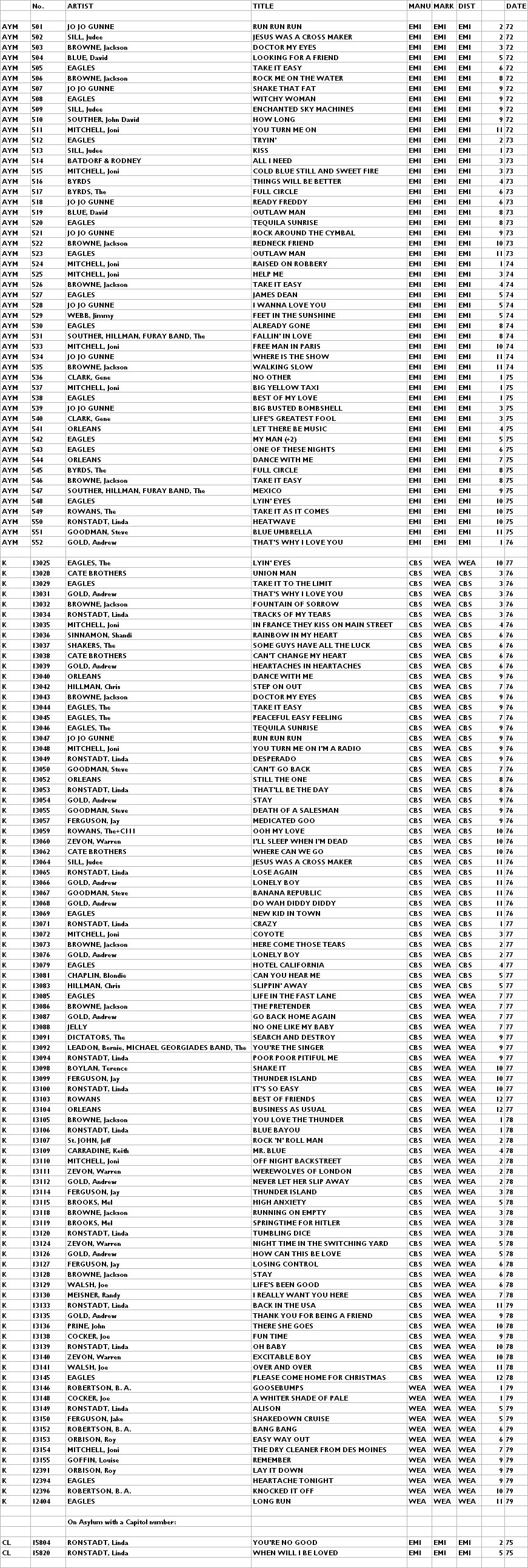


Copyright 2006 Robert Lyons.

